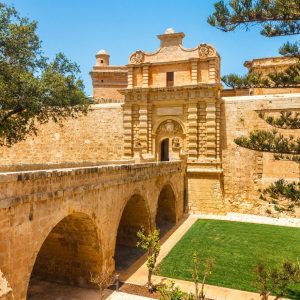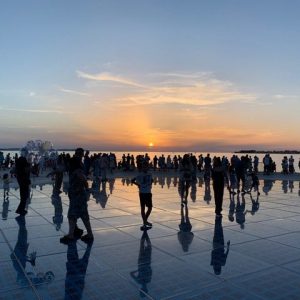The distinguished President Francois Mitterand of France was a great instigator of modern planning and architectural ideas for his capital city, Paris. In his time he was the originator of many post war features including the apparently dead straight ‘Triumphal Way’. This alignment of celebrated structural icons stretches from the Royal Palaces as far as the Grand Arch, some 10 kilometres away, in the La Defense district. In the early eighties Mitterand identified a need for a central entrance to the rabbit warren of passages in the Louvre museum. During 1983 a Chinese-American architect, I.M. Pei, was commissioned to come up with an original idea that would be worthy of an evolving and contemporary city.
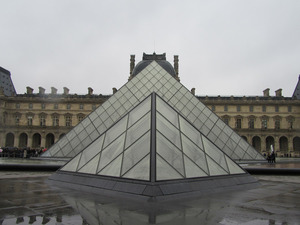 Pei came up with a controversial and brave proposal. He suggested that a collection of ultra-modern glass pyramids could be designed to not only provide the museum entry point but also to compliment other features of the Capital City. The drawings suggested a profound move away from the surrounding Royal Palace Renaissance architectural style. The proposal was regarded by many as a clashing and maverick carbuncle to enforce on the capital. There was much opposition from the traditionalists and there still is, 30 years on. Despite all of that, the programme went ahead and to this day represents an impressively enigmatic feature for a 21st century Paris that is famous around the world. They are known to this day as the ‘Pei Pyramids’.
Pei came up with a controversial and brave proposal. He suggested that a collection of ultra-modern glass pyramids could be designed to not only provide the museum entry point but also to compliment other features of the Capital City. The drawings suggested a profound move away from the surrounding Royal Palace Renaissance architectural style. The proposal was regarded by many as a clashing and maverick carbuncle to enforce on the capital. There was much opposition from the traditionalists and there still is, 30 years on. Despite all of that, the programme went ahead and to this day represents an impressively enigmatic feature for a 21st century Paris that is famous around the world. They are known to this day as the ‘Pei Pyramids’.
The pyramid structures were completed in 1989. That year was the bi- centenary of the ending of the French Revolution. They are now generally accepted as a permanent feature to compliment the older, traditional surrounding landmarks. I was asked nearly 20 years ago what I thought about them as a visitor by a street researcher. Such cold questioning continues to this day and the cosmopolitan reactions remain fiercely controversial.
There are four pyramids built in front of the Royal Palaces in the central Napoleon Courtyard. The largest provides the main entrance to the Louvre Museum and is modelled exactly to the same proportions as the Great Pyramid of Giza in Egypt. The other three pyramids surround the larger one and their axes are all in precise alignment. The positioning fits in precisely with the far stretching plane of the Triumphal Way and they have become a part of it, right in the dead centre of Paris.
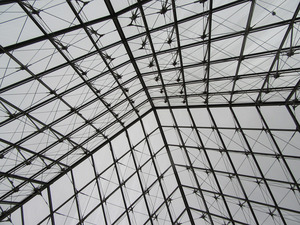 The large pyramid is 116 feet wide and 70 feet high. It is constructed of 95 tons of steel and 105 tons of aluminium. The pyramid presentation is there to reflect the important permanent exhibition of Egyptian history and artefacts in the Louvre museum below. This great structure provides shelter from the elements outside and generates its own micro temperate climate inside. It is as a vast garden greenhouse.
The large pyramid is 116 feet wide and 70 feet high. It is constructed of 95 tons of steel and 105 tons of aluminium. The pyramid presentation is there to reflect the important permanent exhibition of Egyptian history and artefacts in the Louvre museum below. This great structure provides shelter from the elements outside and generates its own micro temperate climate inside. It is as a vast garden greenhouse.
The pyramid, apparently, is composed of 793 diamond and triangular shaped glass panels. I am assured that simple arithmetic, knowing the dimensions, will confirm this but here lies a little mystery. Shortly after the completion, press reports and others stated that the number of panels was 666, the sign of the Devil. It was said that the feature foretold the death of ancient Egypt and the associated exhibition below. Someone should count them all exactly. I make it 673 when the museum entrance is taken into account. Dan Brown mysteriously, in his novel ‘The Da Vinci Code’, makes much of this controversy. After all, the Mona Lisa painted by Leonardo, smiles just beneath.
The pyramid shape has always been linked with somewhat mythical properties. ‘Pyra’ comes from the Greek word for fire and ‘mid’ from middle. Fire in the middle often describes aptly the natural life force found at the centre of a pyramid. Pyramids are said to align themselves with the earth’s magnetic field to create a certain energy, a certain life force. They are said to provide protection from adverse negative activities and dangerous electro-magnetic waves. Regular exposure will help to create a beneficial environment for the body to function and live in. The wearing of a pyramid shaped hat, apparently, improves brain power, relaxation and contemplation. I also read once that blunt knife blades would recover their sharpness if placed under a pyramid for a long period. 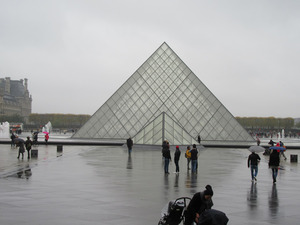 Pyramids are part of mystic ideas and ancient beliefs that still glow with the trace of smoke to this day. The Pei Pyramids as a public structure, even as a sculpture, was a leap into the dark but they have worked and have become accepted universally.
Pyramids are part of mystic ideas and ancient beliefs that still glow with the trace of smoke to this day. The Pei Pyramids as a public structure, even as a sculpture, was a leap into the dark but they have worked and have become accepted universally.
The large Pyramid in Paris with its smaller siblings provides the perfect entrance to the initially submerged galleries of the Louvre museum. The art and mystery begins for visitors before they even descend to the base of the vast museum itself. Strangely, the level of vision seems much clearer looking outside from the inside of the glass pyramid rather than the other way around. The view from the inside to the out is the real one and not the cloudier view of what is initially perceived.
Externally, the four pyramids are complimented by sparkling pools and fountains but they are not alone. There are two other pyramids underground nearby. They are part of the original plan and complete the assembly. Underneath the ground and close to the Arch de Carrousel is a top flight shopping centre in an underpass. In there is erected a similar but smaller pyramid suspended as an inverted feature. Beneath it is placed an erect stone pyramid.
Visitors to Paris cannot help but notice Mr Pie’s pyramids. They really are a massive and contemporary feature of the celebrated cultural quality of artistic Paris. The Pyramids are a little mysterious and cunningly guard to this day their secret and ancient mystic properties.

